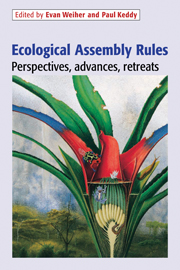Book contents
- Frontmatter
- Contents
- List of Contributors
- Introduction: The scope and goals of research on assembly rules
- Part I The search for meaningful patterns in species assemblages
- 1 The genesis and development of guild assembly rules
- 2 Ruling out a community assembly rule: the method of favored states
- 3 Community structure and assembly rules: confronting conceptual and statistical issues with data on desert rodents
- 4 Introduced avifaunas as natural experiments in community assembly
- 5 Assembly rules in plant communities
- 6 Assembly rules at different scales in plant and bird communities
- 7 Impact of language, history and choice of system on the study of assembly rules
- Part II Other perspectives on community assembly
- Index
1 - The genesis and development of guild assembly rules
Published online by Cambridge University Press: 04 September 2009
- Frontmatter
- Contents
- List of Contributors
- Introduction: The scope and goals of research on assembly rules
- Part I The search for meaningful patterns in species assemblages
- 1 The genesis and development of guild assembly rules
- 2 Ruling out a community assembly rule: the method of favored states
- 3 Community structure and assembly rules: confronting conceptual and statistical issues with data on desert rodents
- 4 Introduced avifaunas as natural experiments in community assembly
- 5 Assembly rules in plant communities
- 6 Assembly rules at different scales in plant and bird communities
- 7 Impact of language, history and choice of system on the study of assembly rules
- Part II Other perspectives on community assembly
- Index
Summary
Introduction
Diamond's assembly rule
The idea that there were rules to govern how communities might be assembled was first explored by Jared Diamond (1975) in his treatise on ‘assembly of species communities’. Although there were inklings of what was to come in earlier papers (Diamond 1973, 1974) the 1975 paper built on his mountain of observational data on the distribution of bird species on the many islands surrounding New Guinea to produce ‘incidence functions’. These incidence functions were then used to deduce or infer the ‘role’ or ‘strategy’ of that species, such as the supertramp strategy already described by Diamond (1974). Diamond's ideas were further developed (covering over 100 pages) culminating in his assembly rules predicting which species were able to coexist on islands in the New Guinea archipelago, in terms of allowed and forbidden combinations. An abbreviated version of his reasoning is shown in Fig. 1.1, which matches the resource utilization curves of four species of birds (dashed lines) to the availability of resources (resource production curves – solid lines) on islands with different levels of resources. By subtracting individual resource utilization curves from resource production curves, it is possible to obtain estimates of the distribution of the remaining resources allowing one to see which additional species could survive and which species requirements would exceed the resource levels available. In this way, Diamond was able to predict allowed and forbidden combinations of species.
- Type
- Chapter
- Information
- Ecological Assembly RulesPerspectives, Advances, Retreats, pp. 23 - 57Publisher: Cambridge University PressPrint publication year: 1999
- 20
- Cited by



